Pre- and Post-Self-Renovation Variations in Indoor Temperature: Methodological Pipeline and Cloud Monitoring Results in Two Small Residential Buildings
Abstract
1. Introduction
1.1. Literature Review
1.2. Study Objectives
- Introduce and demonstrate an affordable and reproducible method for assessing post-intervention building performance by using intelligent building monitoring and management platforms to return results to the end users;
- Conduct post-renovation analyses to study the impact of small typical interventions such as door substitutions or the addition of simple insulation layers, e.g., on the extrados of the last slabs under the unoccupied roof or on the ceiling of a garage located below the living spaces, that are very representative of what arrives in individual houses or in flats of multi-family houses where the residents are also the owners.
1.3. Novelties
- Q1: Is it possible to propose a simple and easily replicable methodology to study the impact of small and punctual retrofitting interventions, including self-renovation ones, that mainly affect IEQ and air temperature conditions?
- Q2: Is it possible to integrate pre- and post-retrofitting impact analyses within newly developed smart middleware monitoring solutions to exploit the untapped potential of those technologies in covering multi-applicational outcomes under long-term continuous monitoring actions?
- Q3: Can these tools inform and support non-expert and expert end users during building operational management and small renovation interventions, reducing the lack of commitment and providing affordable feedback to occupants about their recent self-retrofitting actions and/or behavioural choices?
- Focuses on small retrofitting actions that are generally never analysed in ex-post studies of building renovation due to the small correlation between invested budget and complexity, but which are very typical and diffused in the majority of houses and flats when the residents are the owners (or when the latter owns not the whole building but only a single flat);
- Disseminates the results to users—ones directly defined and, in several cases, directly supported by the renovation actions—connecting retrofitting with direct IEQ variations;
- Uses monitoring data before and after the intervention, and not during only one of the two phases;
- Adopts commercial cloud-based intelligent monitoring solutions to analyse energy, especially IEQ parameters, allowing for the potential integration of this approach with newly diffusing middleware facilities;
- Focuses on IEQ aspects—i.e., temperature—in parallel to energy savings in small houses where thermal variations among rooms may be consistent.
2. Materials and Methods
2.1. Setting the Monitoring Infrastructure
- Allows for high replicability of the solution, adopting a commercial sensor system and balancing the cost/benefit ratio;
- Has a scalable and modular architecture;
- Allows for remote access to data and sensors;
- Supports multi-year cloud and local data storage capacity;
- Reduces data loss by adopting preventive solutions, such as redundant storage and avoidance of data loss during potential connection failures;
- Minimises the need for fixed energy plugs (i.e., based on batteries) to reduce installation costs and to allow for higher acceptability by occupants;
- Includes high-security data access protection protocols;
- Uses gateway connections independent from local Wi-Fi networks, e.g., using independent SIM solutions (facultative).
2.2. Analysis Method
- The statistical distribution of temperatures (average, standard deviation, and quartiles), focusing on the previous result;
- Temperature variations in representative seasonal months—i.e., December for winter and June for summer—comparing measured air temperatures during the air conditioning period (winter heating) and the non-air-conditioned period (summer free-running), respectively, before and after the measurements.
- Twenty-four-hour average daily hourly profiles for representative seasonal months;
- Box and whisker plots reporting statistical distributions of the measured temperatures for the extended heating season (October to April) before and after the renovation, which allow for a comparison of the minimum, first quartile, median (horizontal lines in the boxes), third quartile, and maximum values, plus the outliers as separated dots. Boxes connect the 25th% to the 75th% percentiles. The whiskers represent the first and fourth quarters.
- Scattered plots plotting indoor temperatures as a function of the outdoor ones to detect the impacts of renovation on indoor/outdoor correlations and to support a weather-independent discussion.
2.3. Case Study Description
2.3.1. Demo 1
2.3.2. Demo 2
3. Results
3.1. Demo 1 Results
3.2. Second Demo Results
4. Discussion
4.1. Impacts of Renovation on Energy Bills
4.2. Additional IEQ Thermal Analysis
4.3. Residents’ Feedback
5. Conclusions
- Residents and owners may understand the direct impact of an investment;
- Experts may identify challenges in building management to fully utilise the intervention (for example, an increase in indoor winter temperatures allows for a reduction in the set point to reduce energy consumption);
- Politicians may analyse the impacts of renovation when data are available.
Author Contributions
Funding
Data Availability Statement
Acknowledgments
Conflicts of Interest
Abbreviations
| ACM | Adaptive Comfort Mode |
| EPC | Energy Performance Certification |
| EU | European Union |
| HDD | Heating Degree Days |
| IEQ | Indoor Environmental Quality |
| IQR | Interquartile Range |
| PEf | Primary Energy factor |
| PG | Performance Gap |
| PMV | Predicted Mean Vote |
| PPD | Predicted Percentage of Dissatisfied |
| smc | Standard Cubic Metre (Natural Gas) |
References
- European Union. Directive (EU) 2024/1275 of the European Parliament and of the Council of 24 April 2024 on the Energy Performance of Buildings (Recast); European Union: Brussels, Belgium, 2024; Volume 32024L1275. [Google Scholar]
- European Commission. Energy Performance of Buildings Directive. Available online: https://energy.ec.europa.eu/topics/energy-efficiency/energy-efficient-buildings/energy-performance-buildings-directive_en (accessed on 16 June 2025).
- Ministro Sviluppo Economico; Ministro dell’Ambiente e della Tutela del Territorio e del Mare; Ministro delle Infrastrutture e dei Trasporti; Ministro della Salute; Ministro della Difesa. DECRETO 162 del 26 Giugno 2015—Applicazione Delle Metodologie di Calcolo Delle Prestazioni Energetiche e Definizione Delle Prescrizioni e dei Requisiti Minimi Degli Edifici; 2015; Volume 162/2015. Available online: https://www.gazzettaufficiale.it/eli/id/2015/07/15/15A05198/sg (accessed on 16 June 2025).
- Daedal Research European Building. Renovation Market: Analysis by Building Type (Residential & Non-Residential) by Segment (Energy & Non-Energy Renovation) Size and Trends with Impact of COVID-19 and Forecast up to 2026; Research and Markets: Delhi, India, 2022. [Google Scholar]
- European Commission. The European Green Deal: Striving to Be the First Climate-Neutral Continent. Available online: https://commission.europa.eu/strategy-and-policy/priorities-2019-2024/european-green-deal_en (accessed on 11 August 2024).
- European Union. Next Generation EU. Available online: https://next-generation-eu.europa.eu/index_en (accessed on 11 August 2024).
- European Commission. Renovation Wave. Available online: https://energy.ec.europa.eu/topics/energy-efficiency/energy-efficient-buildings/renovation-wave_en (accessed on 11 August 2024).
- European Commission; Directorate Generale for Energy. Directorate C—Renewables, Research and Innovation, Energy Efficiency Stakeholder Consultation in the Renovation Wave Initiative; European Union: Brussels, Belgium, 2020; Available online: https://energy.ec.europa.eu/system/files/2020-10/stakeholder_consultation_on_the_renovation_wave_initiative_0.pdf (accessed on 16 June 2025).
- Cozza, S.; Chambers, J.; Patel, M.K. Measuring the Thermal Energy Performance Gap of Labelled Residential Buildings in Switzerland. Energy Policy 2020, 137, 111085. [Google Scholar] [CrossRef]
- Gram-Hanssen, K.; Georg, S.; Christiansen, E.; Heiselberg, P. How Building Regulations Ignore the Use of Buildings, What That Means for Energy Consumption and What to Do about It. In Proceedings of the ECEEE Summer Study—Consumption, Efficiency & Limits, Udgivet, Hyeres, France, 29 May–3 June 2017; pp. 2095–2104. [Google Scholar]
- Jain, N.; Burman, E.; Stamp, S.; Mumovic, D.; Davies, M. Cross-Sectoral Assessment of the Performance Gap Using Calibrated Building Energy Performance Simulation. Energy Build. 2020, 224, 110271. [Google Scholar] [CrossRef]
- Cuerda, E.; Guerra-Santin, O.; Sendra, J.J.; Neila, F.J. Understanding the Performance Gap in Energy Retrofitting: Measured Input Data for Adjusting Building Simulation Models. Energy Build. 2020, 209, 109688. [Google Scholar] [CrossRef]
- Chiesa, G.; Pizzuti, S.; Zinzi, M. A New Approach to Assess the Building Energy Performance Gap: Achieving Accuracy through Field Measurements and Input Data Analysis. J. Build. Eng. 2025, 102, 111941. [Google Scholar] [CrossRef]
- Galvin, R. Making the ‘Rebound Effect’ More Useful for Performance Evaluation of Thermal Retrofits of Existing Homes: Defining the ‘Energy Savings Deficit’ and the ‘Energy Performance Gap’. Energy Build. 2014, 69, 515–524. [Google Scholar] [CrossRef]
- Grossmann, D.; Galvin, R.; Weiss, J.; Madlener, R.; Hirschl, B. A Methodology for Estimating Rebound Effects in Non-Residential Public Service Buildings: Case Study of Four Buildings in Germany. Energy Build. 2016, 111, 455–467. [Google Scholar] [CrossRef]
- CORDIS-EU Research Results Next-Generation of Energy Performance Assessment and Certification. Available online: https://cordis.europa.eu/programme/id/H2020_LC-SC3-EE-5-2018-2019-2020/en (accessed on 16 June 2025).
- Larsen, O.K.; Pomianowski, M.Z.; Chiesa, G.; Belias, E.; De Kerchove d’Exaerde, T.; Flourentzou, F.; Fasano, F.; Grasso, P. E-DYCE—Dynamic Approach to the Dynamic Energy Certification of Buildings. J. Phys. Conf. Ser. 2023, 2600, 032015. [Google Scholar] [CrossRef]
- Chiesa, G.; Fasano, F.; Grasso, P. Simulated vs Monitored Building Behaviours: Sample Demo Applications of a Performance Gap Detection Tool in a Northern-Italian Climate. In Towards Net Zero Carbon Emissions in the Building Industry; Innovative Renewable Energy; Springer: Cham, Switzerland, 2022. [Google Scholar]
- Flourentzou, F.; Ivanov, A.Y.; Samuel, P. Understand, Simulate, Anticipate and Correct Performance Gap in NZEB Refurbishment of Residential Buildings. J. Phys. Conf. Ser. 2019, 1343, 012177. [Google Scholar] [CrossRef]
- Bunn, R.; Burman, E. S-Curves to Model and Visualise the Energy Performance Gap between Design and Reality—First Steps to a Practical Tool. In Proceedings of the CIBSE Technical Symposium, London, UK, 16–17 April 2015; CIBSE: London, UK, 2015; pp. 1–18. [Google Scholar]
- Jradi, M.; Arendt, K.; Sangogboye, F.C.; Mattera, C.G.; Markoska, E.; Kjærgaard, M.B.; Veje, C.T.; Jørgensen, B.N. ObepME: An Online Building Energy Performance Monitoring and Evaluation Tool to Reduce Energy Performance Gaps. Energy Build. 2018, 166, 196–209. [Google Scholar] [CrossRef]
- van Dronkelaar, C.; Dowson, M.; Spataru, C.; Mumovic, D. A Review of the Regulatory Energy Performance Gap and Its Underlying Causes in Non-Domestic Buildings. Front. Mech. Eng. 2016, 1, 17. [Google Scholar] [CrossRef]
- Chiesa, G.; Pomianowski, M. EDYCE D5.6—Demonstration and Policy Contribution Report; E-DYCE Report; EDYCE: Santiago, Chile, 2023; p. 148. [Google Scholar]
- Cozza, S.; Chambers, J.; Deb, C.; Scartezzini, J.-L.; Schlüter, A.; Patel, M.K. Do Energy Performance Certificates Allow Reliable Predictions of Actual Energy Consumption and Savings? Learning from the Swiss National Database. Energy Build. 2020, 224, 110235. [Google Scholar] [CrossRef]
- Zheng, Z.; Zhou, J.; Jiaqin, Z.; Yang, Y.; Xu, F.; Liu, H. Review of the Building Energy Performance Gap from Simulation and Building Lifecycle Perspectives: Magnitude, Causes and Solutions. Dev. Built Environ. 2024, 17, 100345. [Google Scholar] [CrossRef]
- Mahdavi, A.; Berger, C.; Amin, H.; Ampatzi, E.; Andersen, R.K.; Azar, E.; Barthelmes, V.M.; Favero, M.; Hahn, J.; Khovalyg, D.; et al. The Role of Occupants in Buildings’ Energy Performance Gap: Myth or Reality? Sustainability 2021, 13, 3146. [Google Scholar] [CrossRef]
- Amasyali, K.; El-Gohary, N.M. A Review of Data-Driven Building Energy Consumption Prediction Studies. Renew. Sustain. Energy Rev. 2018, 81, 1192–1205. [Google Scholar] [CrossRef]
- Coakley, D.; Raftery, P.; Keane, M. A Review of Methods to Match Building Energy Simulation Models to Measured Data. Renew. Sustain. Energy Rev. 2014, 37, 123–141. [Google Scholar] [CrossRef]
- Haverinen-Shaughnessy, U.; Pekkonen, M.; Leivo, V.; Prasauskas, T.; Turunen, M.; Kiviste, M.; Aaltonen, A.; Martuzevicius, D. Occupant Satisfaction with Indoor Environmental Quality and Health after Energy Retrofits of Multi-Family Buildings: Results from INSULAtE-Project. Int. J. Hyg. Environ. Health 2018, 221, 921–928. [Google Scholar] [CrossRef]
- Vivian, J.; Carnieletto, L.; Cover, M.; De Carli, M. At the Roots of the Energy Performance Gap: Analysis of Monitored Indoor Air before and after Building Retrofits. Build. Environ. 2023, 246, 110914. [Google Scholar] [CrossRef]
- La Fleur, L.; Moshfegh, B.; Rohdin, P. Measured and Predicted Energy Use and Indoor Climate before and after a Major Renovation of an Apartment Building in Sweden. Energy Build. 2017, 146, 98–110. [Google Scholar] [CrossRef]
- Papadopoulos, F.; Whiffen, T.R.; Tilford, A.; Willson, C. Actual Energy and Environmental Savings on Energy Retrofit Works at the Lakes Estate, Milton Keynes. Sustain. Cities Soc. 2018, 41, 611–624. [Google Scholar] [CrossRef]
- Xin, L.; Chenchen, W.; Chuanzhi, L.; Guohui, F.; Zekai, Y.; Zonghan, L. Effect of the Energy-Saving Retrofit on the Existing Residential Buildings in the Typical City in Northern China. Energy Build. 2018, 177, 154–172. [Google Scholar] [CrossRef]
- Pedersen, E.; Gao, C.; Wierzbicka, A. Tenant Perceptions of Post-Renovation Indoor Environmental Quality in Rental Housing: Improved for Some, but Not for Those Reporting Health-Related Symptoms. Build. Environ. 2021, 189, 107520. [Google Scholar] [CrossRef]
- Larsen, O.K.; Hu, Y.; Pomianowski, M.Z. Towards Feasible and Credible Building Modelling Reflecting the Operational Energy Use and Indoor Environment—Nordic Climate Case Study. Energy Build. 2024, 317, 114346. [Google Scholar] [CrossRef]
- Synnefa, A.; Vasilakopoulou, K.; Kyriakodis, G.-E.; Lontorfos, V.; De Masi, R.F.; Mastrapostoli, E.; Karlessi, T.; Santamouris, M. Minimizing the Energy Consumption of Low Income Multiple Housing Using a Holistic Approach. Energy Build. 2017, 154, 55–71. [Google Scholar] [CrossRef]
- Jankovic, L. Lessons Learnt from Design, off-Site Construction and Performance Analysis of Deep Energy Retrofit of Residential Buildings. Energy Build. 2019, 186, 319–338. [Google Scholar] [CrossRef]
- Tomrukcu, G.; Ashrafian, T. Climate-Resilient Building Energy Efficiency Retrofit: Evaluating Climate Change Impacts on Residential Buildings. Energy Build. 2024, 316, 114315. [Google Scholar] [CrossRef]
- Blázquez, T.; Suárez, R.; Ferrari, S.; Sendra, J.J. Improving Winter Thermal Comfort in Mediterranean Buildings Upgrading the Envelope: An Adaptive Assessment Based on a Real Survey. Energy Build. 2023, 271, 112615. [Google Scholar] [CrossRef]
- Pomianowski, M.Z.; Wittchen, K.; Schaffer, M.; Hu, Y.; Chiesa, G.; Fasano, F.; Grasso, P. Method Combining Expert and Analytical Approaches towards Economical Energy Renovation Roadmaps and Improved Indoor Comfort. J. Phys. Conf. Ser. 2023, 2600, 082022. [Google Scholar] [CrossRef]
- DPR 412/1993 Decreto del Presidente Della Repubblica 26 Agosto 1993, n. 412—Regolamento Recante Norme per la Progettazione, L’installazione, L’esercizio e la Manutenzione Degli Impianti Termici Degli Edifici ai Fini del Contenimento dei Consumi Di Energia, in Attuazione Dell’art. 4, Comma 4, Della Legge 9 Gennaio 1991, N. 10 e Successive Modificazioni. 1993. Available online: https://www.gazzettaufficiale.it/eli/id/1993/10/14/093G0451/sg (accessed on 16 June 2025).
- Climate Data Data and Graphs for Weather & CLimate in Torre Pellice. Available online: https://en.climate-data.org/europe/italy/piemont/torre-pellice-112812/ (accessed on 16 June 2025).
- Beck, H.E.; Zimmermann, N.E.; McVicar, T.R.; Vergopolan, N.; Berg, A.; Wood, E.F. Present and Future Köppen-Geiger Climate Classification Maps at 1-Km Resolution. Sci. Data 2018, 5, 180214. [Google Scholar] [CrossRef]
- Capetti Elettronica Capetti Winecap System 2025. Available online: https://www.capetti.it/en/news/winecap-product-catalogue (accessed on 16 June 2025).
- Snell, J.; Tidwell, D.; Kulchenko, P. Programming Web Services with SOAP, 1st ed.; O’Reilly & Associates: Sebastopol, CA, USA, 2002; ISBN 978-0-596-00095-0. [Google Scholar]
- Thies Clima Thies Climate Sensor US. Available online: https://www.thiesclima.com/en/Products/Wind-Combi-sensors/?art=197 (accessed on 16 June 2025).
- Delta Ohm LP Pyra 02. Available online: https://www.geass.com/wp-content/uploads/filebase/delta_ohm/piranometri/Piranometri-Delta-Ohm-LP_PYRA02_03_12_it.pdf (accessed on 16 June 2025).
- Chiesa, G.; Fasano, F.; Grasso, P. Energy Simulation Platform Supporting Building Design and Management. Techne 2023, 25, 134–142. [Google Scholar] [CrossRef]
- Chiesa, G.; Fasano, F.; Grasso, P. A New Tool for Building Energy Optimization: First Round of Successful Dynamic Model Simulations. Energies 2021, 14, 6429. [Google Scholar] [CrossRef]
- Sadauskiene, J.; Seduikyte, L. Moisture Accumulation in Renovated External Walls. In Proceedings of the International Conference “Innovative Materials, Structures and Technologies”, Riga, Latvia, 7 August 2014; Riga Technical University: Riga, Latvia, 2014; p. 151. [Google Scholar]
- CEN EN 16798-1:2019; Energy Performance of Buildings. Ventilation for Buildings. Indoor Environmental Input Parameters for Design and Assessment of Energy Performance of Buildings Addressing Indoor Air Quality, Thermal Environment, Lighting and Acoustics. Module M1-6. CEN: Brussels, Belgium, 2019; ISBN 978-0-580-85868-0.
- CTI UNI/TS 11300-5; Prestazioni Energetiche Degli Edifici—Parte 5: Calcolo Dell’energia Primaria e Della Quota Di Energia Da Fonti Rinnovabili. UNI: Milan, Italy, 2016.
- CTI UNI/TS 11300-1; Prestazioni Energetiche Degli Edifici—Parte 1: Determinazione Del Fabbisogno Di Energia Termica Dell’edificio per La Climatizzazione Estiva Ed Invernale. UNI: Milan, Italy, 2014.
- UNI 10349-3:2016; Riscaldamento e Raffrescamento Degli Edifici—Dati Climatici—Parte 3: Differenze Di Temperature Cumulate (Gradi Giorno) Ed Altri Indicatori Sintetici (Heating and Cooling of Buildings—Climatic Data—Part 3: Accumulated Temperature Differences (Degree-Days) and Other Indices). UNI: Milan, Italy, 2016.
- Repubblica Italiana. ENEA Tab.A Allegata al D.P.R. 412/93 Aggiornata al 31 Ottobre 2009—Zone Climatiche Elenco Dei Comuni Italiani Diviso per Regioni e Provincie; Repubblica Italiana: Rome, Italy, 2009. [Google Scholar]
- EN ISO 7730:2005; Ergonomics of the Thermal Environment. Analytical Determination and Interpretation of Thermal Comfort Using Calculation of the PMV and PPD Indices and Local Thermal Comfort Criteria. CEN: Brussels, Belgium, 2006; ISBN 0-580-47207-8.
- PD CEN/TR 16798-2:2019; Energy Performance of Buildings. Ventilation for Buildings. Interpretation of the Requirements in EN 16798-1. Indoor Environmental Input Parameters for Design and Assessment of Energy Performance of Buildings Addressing Indoor Air Quality, Thermal Environment, Lighting and Acoustics (Module M1-6). BSI: London, UK, 2019; ISBN 978-0-580-85867-3.
- Ahmad, M.W.; Mourshed, M.; Mundow, D.; Sisinni, M.; Rezgui, Y. Building Energy Metering and Environmental Monitoring—A State-of-the-Art Review and Directions for Future Research. Energy Build. 2016, 120, 85–102. [Google Scholar] [CrossRef]
- Guerra-Santin, O.; Tweed, C.A. In-Use Monitoring of Buildings: An Overview of Data Collection Methods. Energy Build. 2015, 93, 189–207. [Google Scholar] [CrossRef]
- Juraszek, J.; Antonik-Popiołek, P. Fibre Optic FBG Sensors for Monitoring of the Temperature of the Building Envelope. Materials 2021, 14, 1207. [Google Scholar] [CrossRef] [PubMed]
- Magunov, A.N.; Pylnev, M.A.; Lapshinov, B.A. Spectral Pyrometry of Objects with Unknown Emissivities in a Temperature Range of 400–1200 K. Instrum. Exp. Tech. 2014, 57, 86–90. [Google Scholar] [CrossRef]

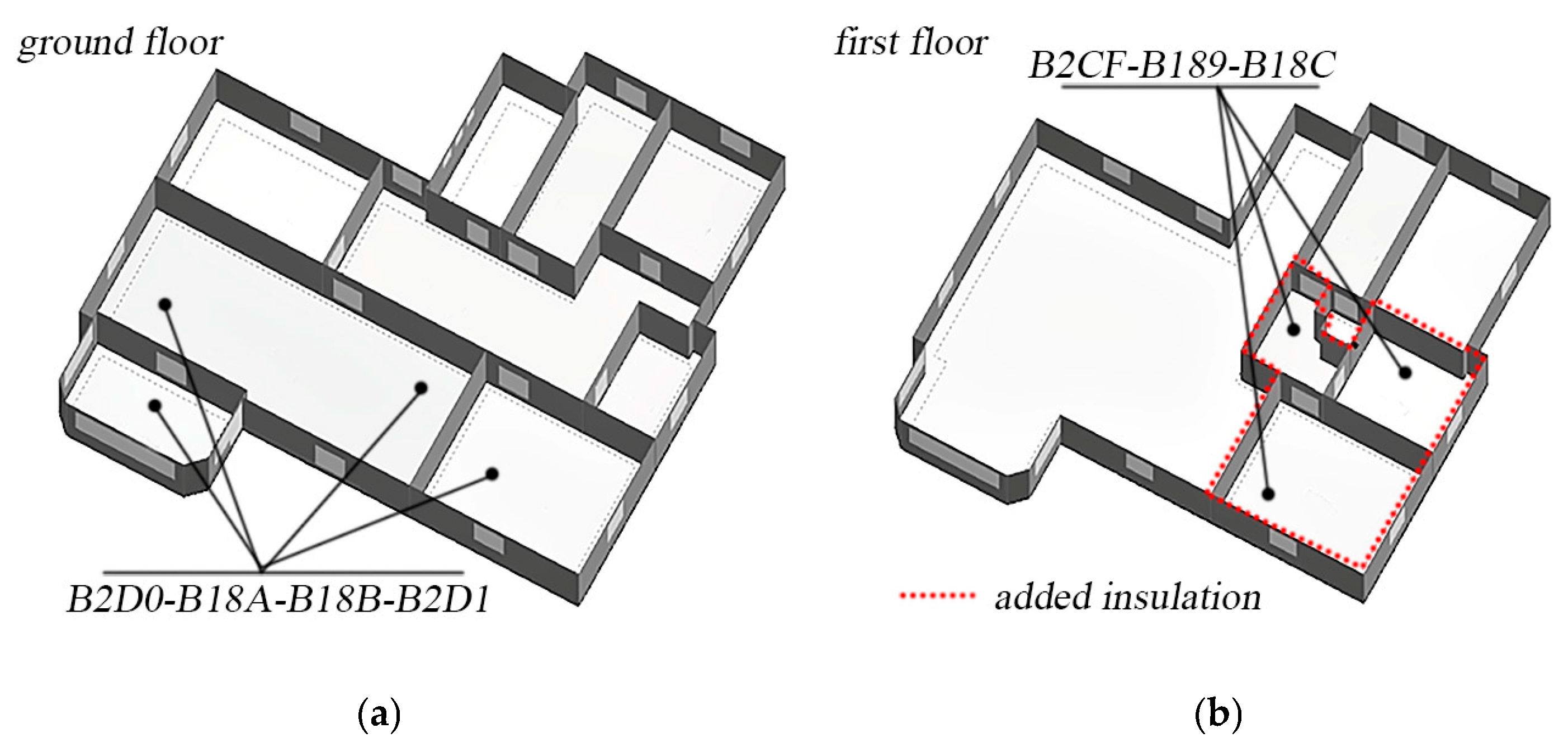
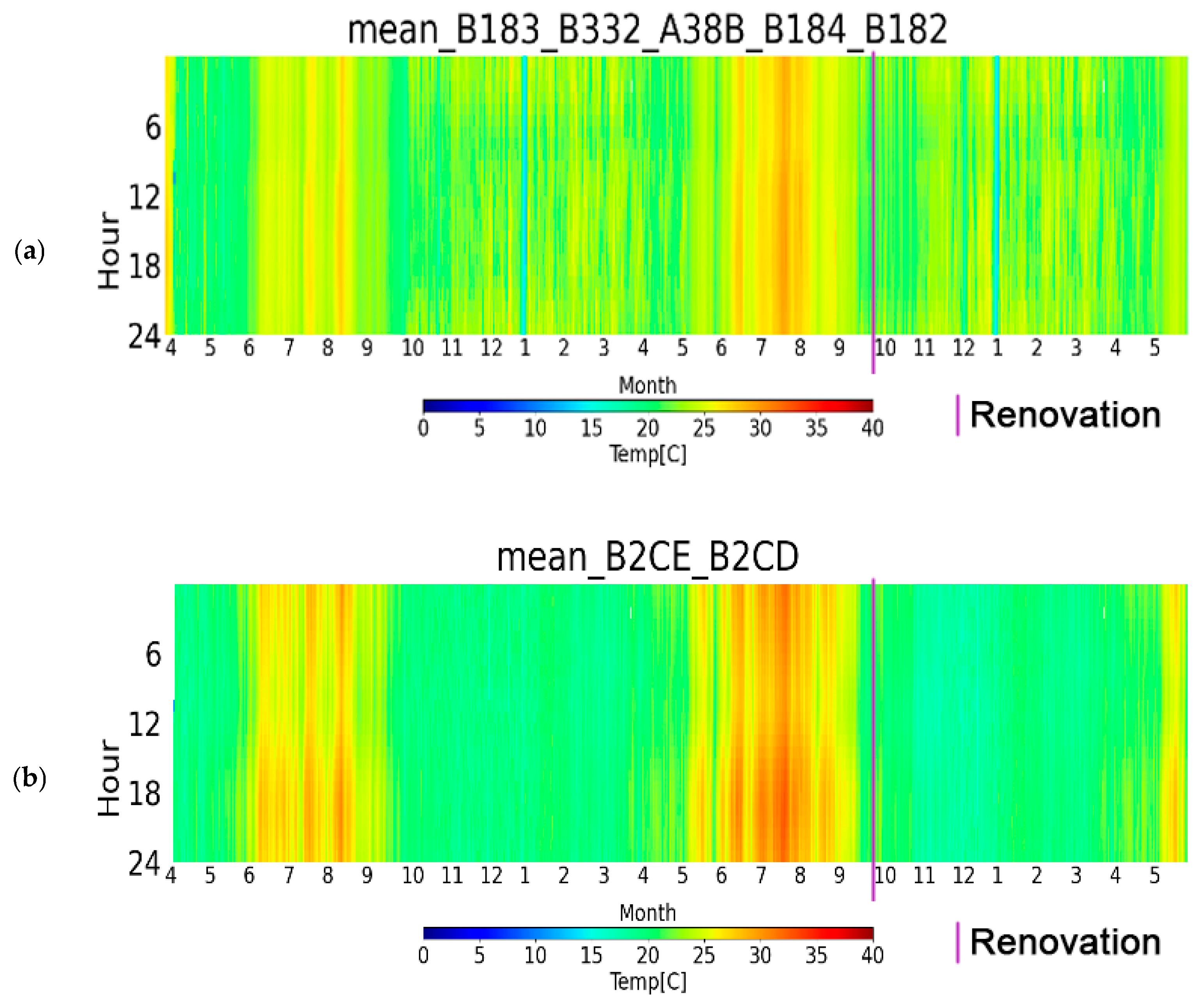

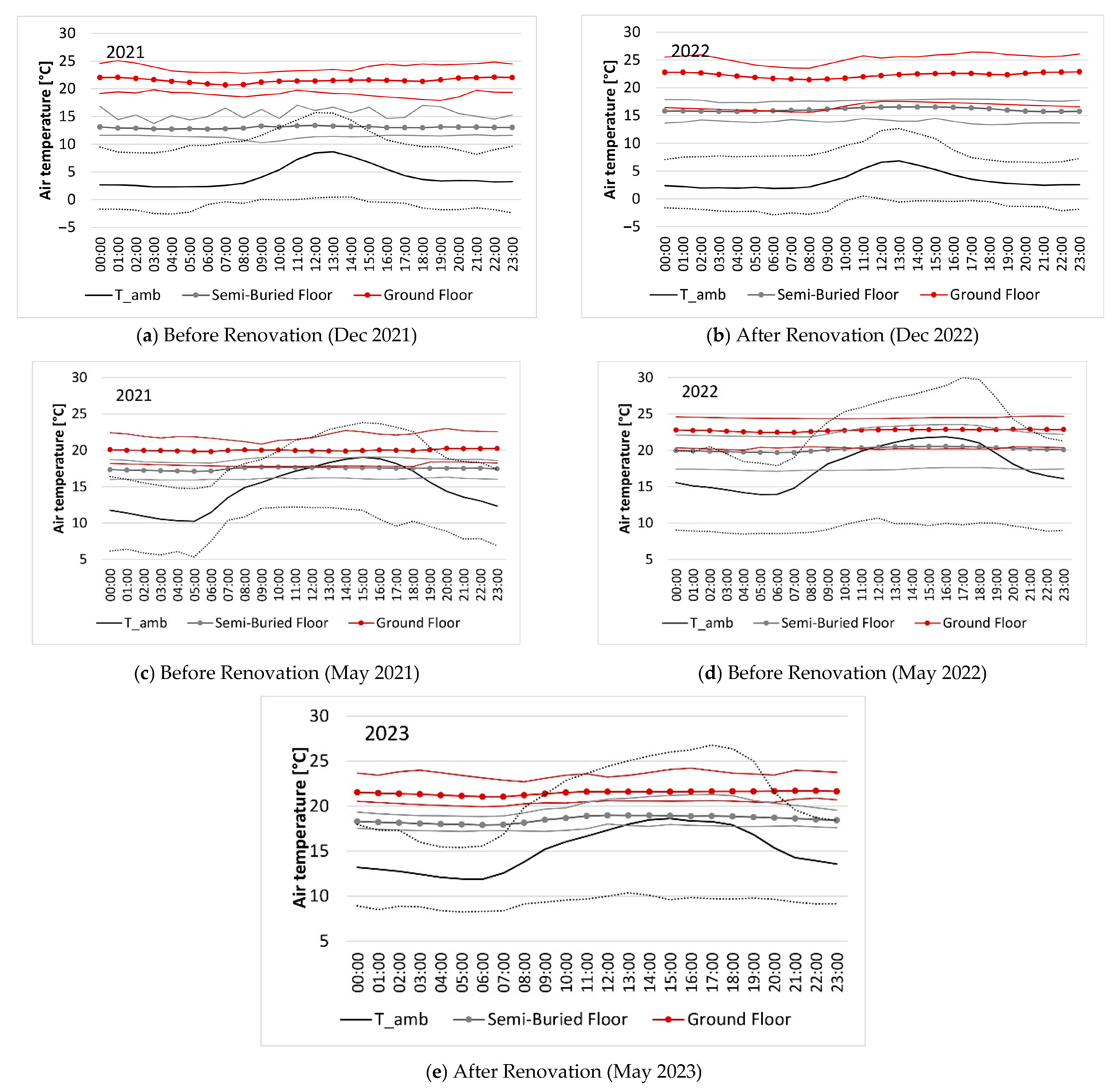
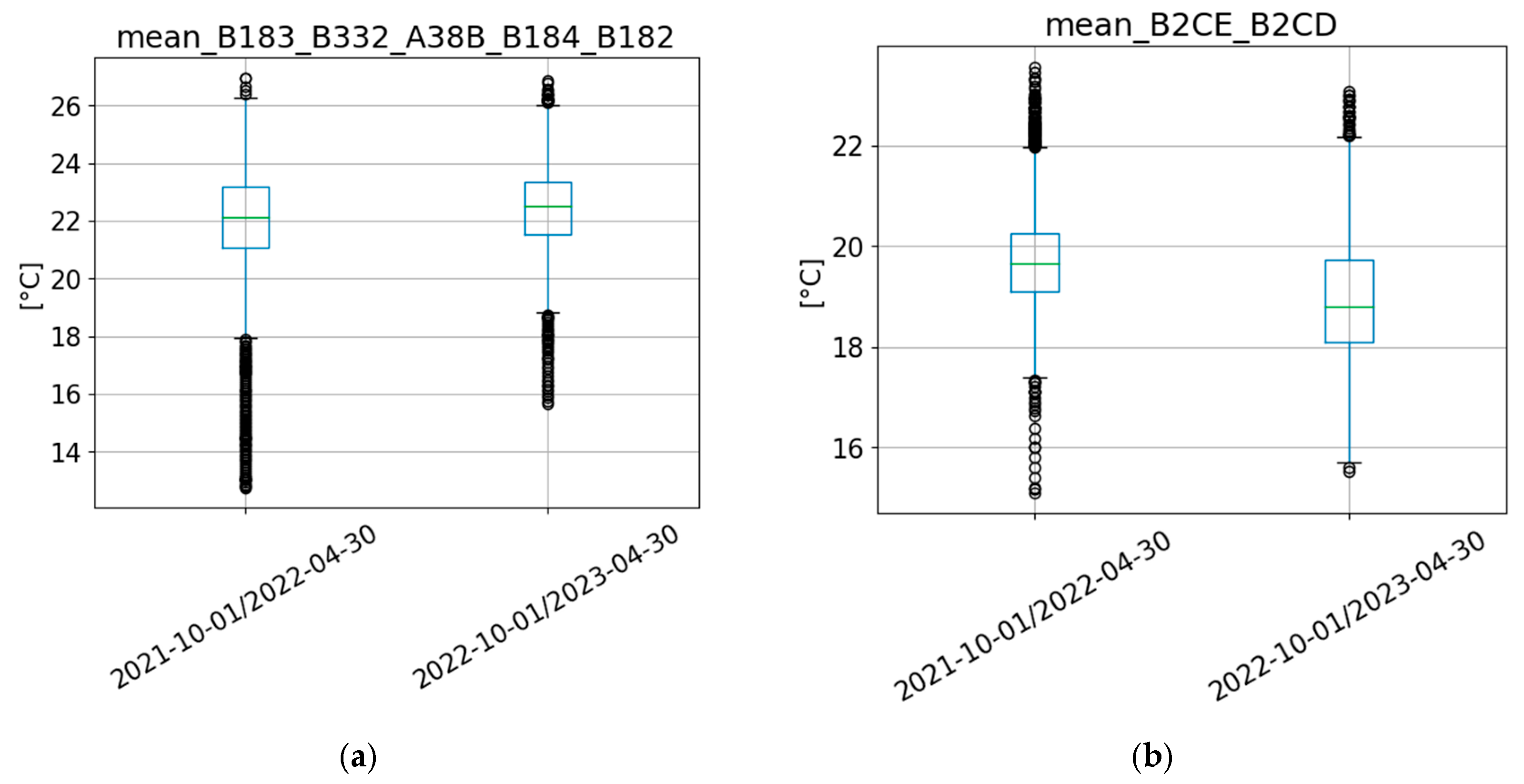

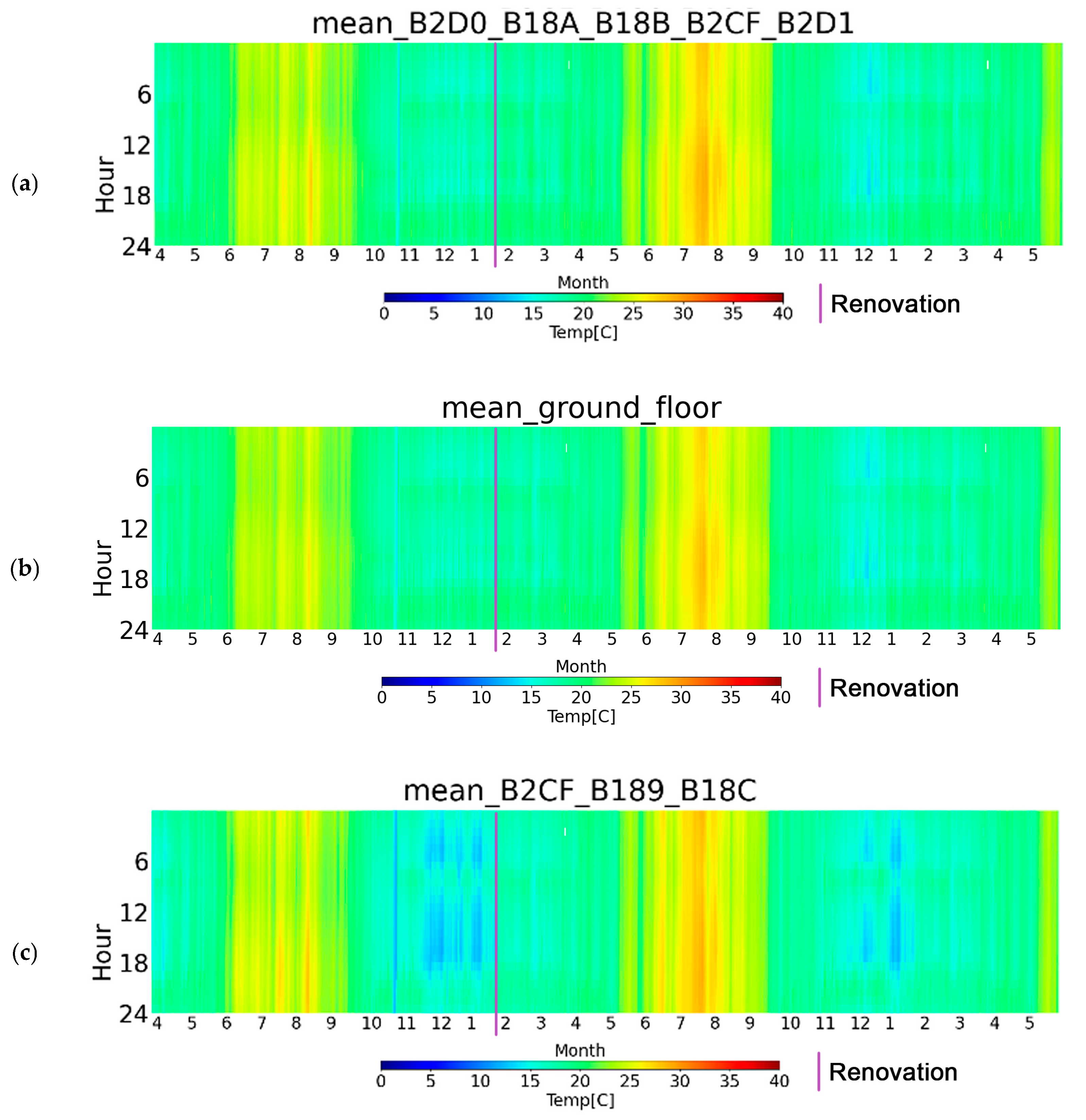



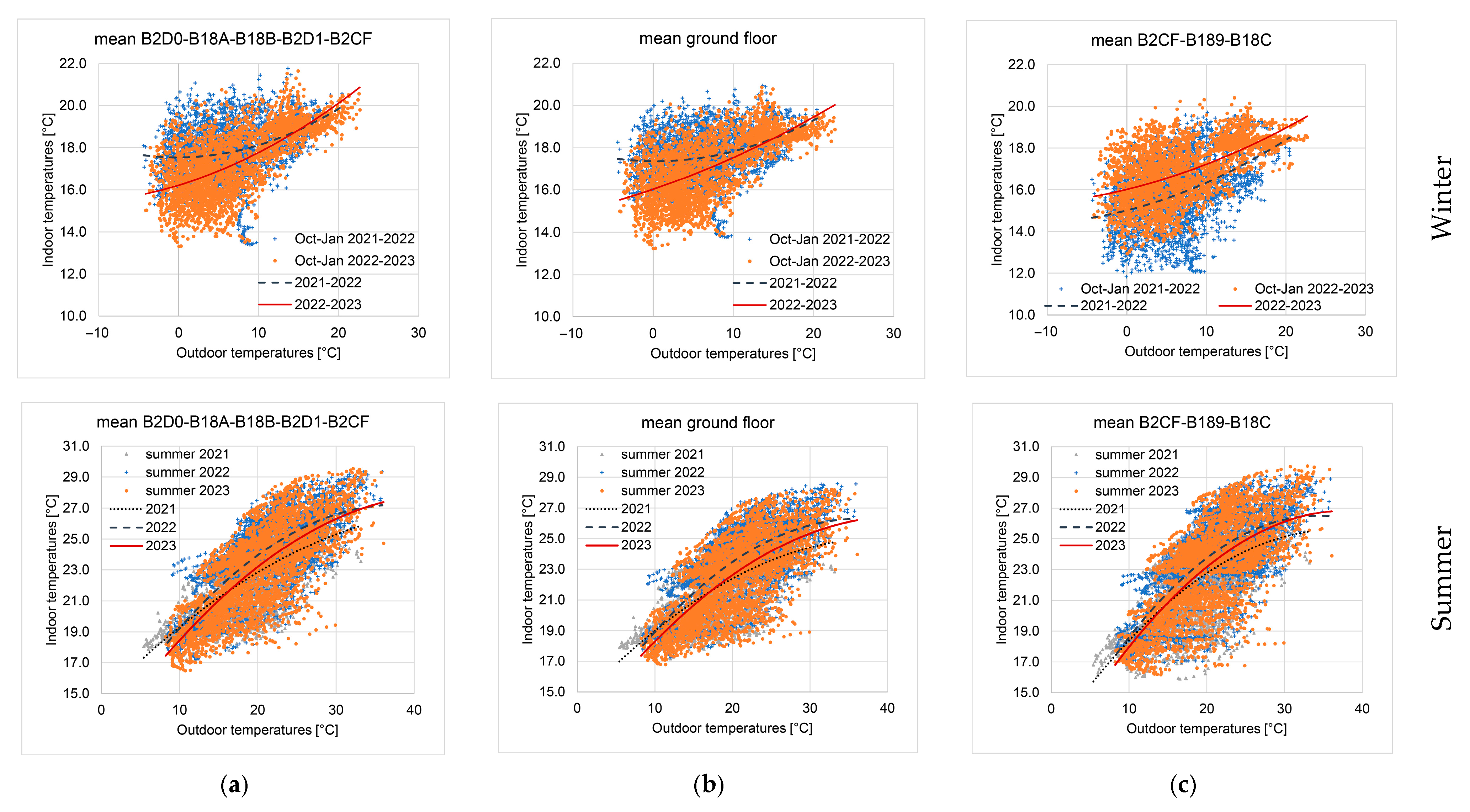

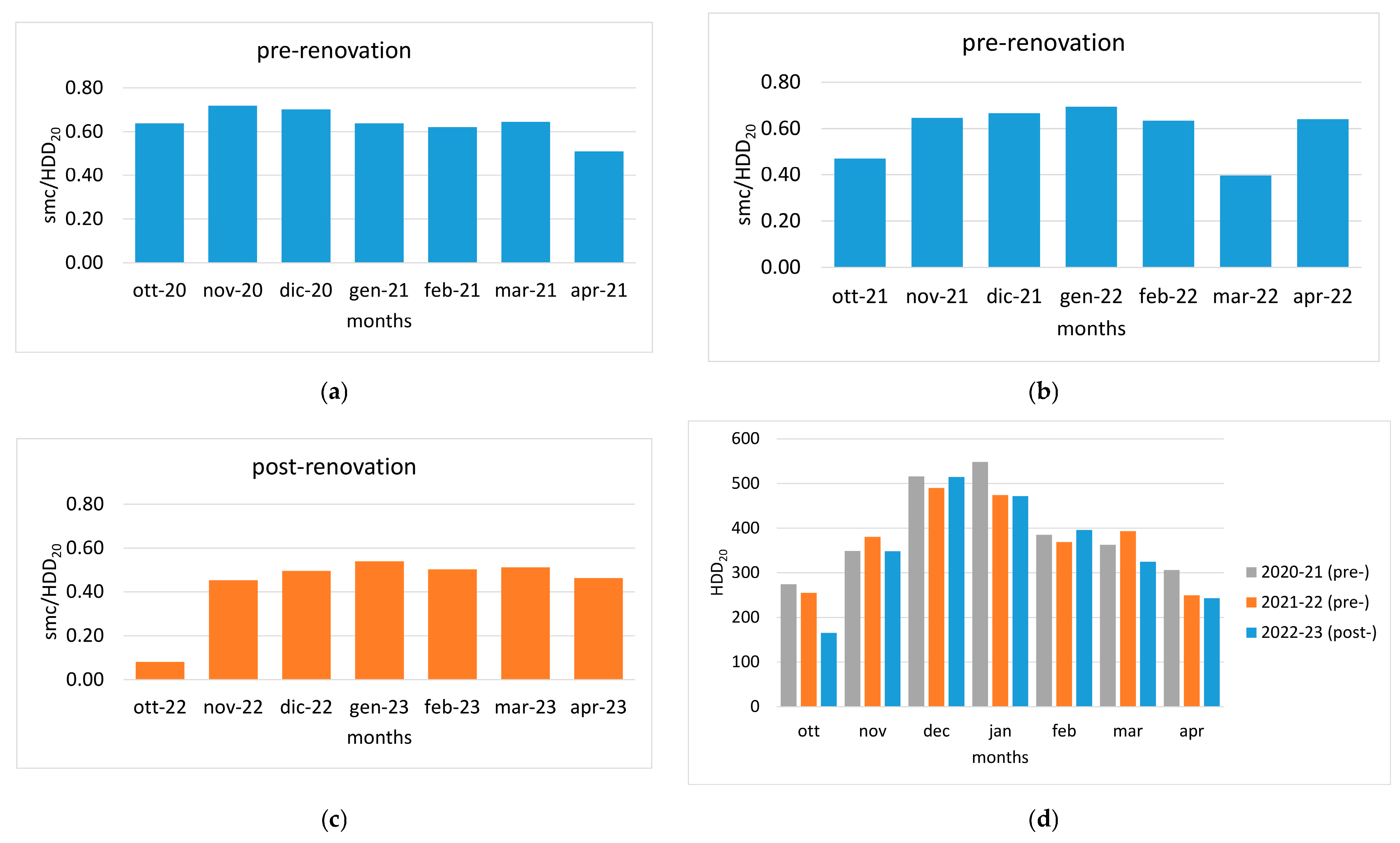


| WSD00TH2CO_S and WSD00TH2CO | Indoor Temperature | Relative Humidity | CO2 Concentration |
|---|---|---|---|
| Transducer type | NTC10KΩ | CMOSens® tech. | NDIR principle |
| Measurement range | −10 °C ÷ +60 °C | 0 ÷ 100% | 0 ÷ 5000 ppm |
| Measurement precision | ±0.2 °C whole range | ±2.0% (typical) from 0% to 100% | <±50 ppm (+3% of measured value) whole range |
| Measurement resolution | 0.01 °C | 0.05% RH | 1 ppm |
| WSD00TH2_LD | Indoor Temperature | Relative Humidity | |
| Transducer type | NTC10KΩ | CMOSens® tech. | |
| Measurement range | −10 °C ÷ +60 °C | 0 ÷ 100% | |
| Measurement precision | ±0.2 °C whole range | ±2.0% (typical) from 0% to 100% | |
| Measurement resolution | 0.01 °C | 0.05% RH |
| Ground Floor | First Floor | |||||||||||||||
|---|---|---|---|---|---|---|---|---|---|---|---|---|---|---|---|---|
| Temperature [°C] | Relative Humidity [%] | Temperature [°C] | Relative Humidity [%] | |||||||||||||
| Season | Av. | std | 25th | 75th | Av. | std | 25th | 75th | Av. | std | 25th | 75th | Av. | std | 25th | 75th |
| sum 2021 | 23.06 | 2.17 | 21.03 | 24.84 | 56.44 | 7.44 | 52.71 | 61.90 | 24.15 | 2.75 | 21.86 | 26.35 | 54.25 | 5.47 | 51.36 | 57.96 |
| sum 2022 | 24.85 | 2.16 | 23.46 | 26.62 | 54.37 | 6.23 | 50.68 | 58.34 | 26.08 | 3.01 | 24.38 | 28.32 | 51.85 | 4.89 | 48.47 | 55.68 |
| sum 2023 | 24.05 | 2.33 | 21.73 | 25.63 | 58.60 | 6.46 | 55.54 | 62.85 | 25.11 | 3.24 | 22.53 | 27.69 | 57.18 | 5.31 | 54.28 | 60.75 |
| win 2021–2022 | 22.05 | 1.71 | 21.07 | 23.19 | 35.05 | 9.60 | 27.44 | 42.41 | 19.74 | 0.93 | 19.10 | 20.25 | 42.23 | 9.24 | 35.36 | 47.92 |
| win 2022–2023 | 22.45 | 1.35 | 21.53 | 23.34 | 39.18 | 11.17 | 31.52 | 43.92 | 18.96 | 1.13 | 18.10 | 19.73 | 49.34 | 10.36 | 41.74 | 54.82 |
| Outdoor conditions | ||||||||||||||||
| sum 2021 | 21.36 | 5.28 | 17.96 | 25.23 | 64.38 | 15.95 | 53.00 | 76.00 | ||||||||
| sum 2022 | 20.29 | 5.17 | 16.54 | 24.02 | 70.65 | 15.88 | 60.00 | 82.00 | ||||||||
| sum 2023 | 19.72 | 5.38 | 15.64 | 23.24 | 72.91 | 14.22 | 63.00 | 83.00 | ||||||||
| win 2021–2022 | 7.65 | 4.84 | 4.09 | 10.68 | 63.14 | 21.56 | 46.00 | 81.00 | ||||||||
| win 2022–2023 | 8.44 | 5.54 | 4.13 | 12.86 | 69.21 | 19.68 | 56.00 | 85.00 | ||||||||
| Ground Floor | First Floor | |||||||||||||||
|---|---|---|---|---|---|---|---|---|---|---|---|---|---|---|---|---|
| Temperature [°C] | Relative Humidity [%] | Temperature [°C] | Relative Humidity [%] | |||||||||||||
| Season | Av. | std | 25th | 75th | Av. | std | 25th | 75th | Av. | std | 25th | 75th | Av. | std | 25th | 75th |
| sum 2021 | 22.05 | 2.00 | 20.31 | 23.58 | 62.67 | 5.38 | 59.75 | 66.34 | 22.30 | 2.55 | 20.11 | 24.38 | 62.06 | 4.63 | 59.76 | 64.69 |
| sum 2022 | 23.52 | 2.45 | 22.17 | 25.44 | 62.79 | 5.67 | 58.96 | 67.19 | 23.76 | 2.78 | 22.50 | 25.90 | 61.65 | 6.42 | 57.52 | 66.52 |
| sum 2023 | 22.44 | 2.59 | 20.25 | 24.31 | 68.83 | 6.18 | 65.99 | 72.92 | 22.90 | 3.00 | 20.74 | 24.81 | 68.94 | 7.30 | 65.19 | 74.58 |
| win 2021–2022 * | 17.64 | 1.16 | 16.88 | 18.44 | 57.02 | 8.57 | 49.42 | 64.70 | 15.82 | 1.64 | 14.64 | 16.92 | 67.90 | 6.90 | 62.57 | 73.86 |
| win 2022–2023 * | 17.13 | 1.46 | 15.94 | 18.40 | 66.83 | 6.96 | 61.42 | 72.46 | 16.91 | 1.43 | 15.83 | 18.17 | 73.94 | 5.90 | 69.26 | 79.27 |
| Demo | Period | Cat. I | Cat. II | Cat. III | Cat. IV | Outside | PMV av. | PMV std | PPD av. | PPD std |
|---|---|---|---|---|---|---|---|---|---|---|
| Ground floor | ||||||||||
| 1 | Summer 2021 | 27% | 30% | 11% | 8% | 25% | −0.36 | 0.71 | 17.85 | 17.35 |
| Summer 2022 | 32% | 30% | 8% | 18% | 13% | 0.11 | 0.63 | 13.40 | 11.86 | |
| Summer 2023 | 28% | 20% | 11% | 25% | 16% | −0.02 | 0.70 | 15.22 | 11.14 | |
| Winter 2021–2022 | 43% | 38% | 10% | 5% | 4% | 0.03 | 0.43 | 8.88 | 7.06 | |
| Winter 2022–2023 | 39% | 40% | 13% | 6% | 2% | 0.14 | 0.38 | 8.42 | 5.06 | |
| 2 | Summer 2021 | 18% | 25% | 17% | 10% | 29% | −0.68 | 0.61 | 21.77 | 20.72 |
| Summer 2022 | 18% | 28% | 18% | 20% | 17% | −0.33 | 0.70 | 17.18 | 15.98 | |
| Summer 2023 | 12% | 21% | 12% | 19% | 36% | −0.59 | 0.77 | 24.02 | 19.69 | |
| Winter 2021–2022 * | 4% | 15% | 23% | 36% | 22% | −0.75 | 0.40 | 19.98 | 12.31 | |
| Winter 2022–2023 * | 4% | 15% | 22% | 27% | 32% | −0.79 | 0.44 | 21.98 | 13.65 | |
| First floor | ||||||||||
| 1 | Summer 2021 | 15% | 26% | 15% | 18% | 26% | −0.11 | 0.83 | 19.39 | 15.43 |
| Summer 2022 | 13% | 20% | 14% | 20% | 34% | 0.28 | 0.93 | 24.01 | 19.84 | |
| Summer 2023 | 9% | 21% | 20% | 19% | 31% | 0.05 | 0.97 | 23.69 | 20.33 | |
| Winter 2021–2022 | 14% | 46% | 25% | 7% | 7% | −0.31 | 0.49 | 11.98 | 10.15 | |
| Winter 2022–2023 | 14% | 23% | 28% | 29% | 6% | −0.41 | 0.50 | 13.73 | 8.20 | |
| 2 | Summer 2021 | 21% | 21% | 14% | 10% | 34% | −0.66 | 0.77 | 24.89 | 23.67 |
| Summer 2022 | 17% | 25% | 12% | 20% | 25% | −0.31 | 0.82 | 20.38 | 19.01 | |
| Summer 2023 | 16% | 18% | 9% | 20% | 38% | −0.48 | 0.89 | 24.93 | 21.03 | |
| Winter 2021–2022 * | 4% | 9% | 13% | 32% | 42% | −0.91 | 0.51 | 27.20 | 17.24 | |
| Winter 2022–2023 * | 4% | 12% | 25% | 28% | 31% | −0.79 | 0.48 | 22.66 | 15.34 | |
| Ground Floor | First Floor | ||||||||
|---|---|---|---|---|---|---|---|---|---|
| Building | Period | Cat. I | Cat. II. | Cat. III | Outside | Cat. I | Cat. II | Cat. III | Outside |
| 1 | Summer 2021 | 74% | 19% | 6% | 0% | 79% | 16% | 4% | 0% |
| Summer 2022 | 97% | 3% | 0% | 0% | 73% | 18% | 7% | 2% | |
| Summer 2023 | 86% | 14% | 0% | 0% | 72% | 19% | 7% | 2% | |
| 2 | Summer 2021 | 54% | 24% | 18% | 4% | 58% | 15% | 16% | 11% |
| Summer 2022 | 70% | 18% | 10% | 1% | 76% | 10% | 9% | 5% | |
| Summer 2023 | 52% | 18% | 21% | 8% | 60% | 17% | 11% | 11% | |
Disclaimer/Publisher’s Note: The statements, opinions and data contained in all publications are solely those of the individual author(s) and contributor(s) and not of MDPI and/or the editor(s). MDPI and/or the editor(s) disclaim responsibility for any injury to people or property resulting from any ideas, methods, instructions or products referred to in the content. |
© 2025 by the authors. Licensee MDPI, Basel, Switzerland. This article is an open access article distributed under the terms and conditions of the Creative Commons Attribution (CC BY) license (https://creativecommons.org/licenses/by/4.0/).
Share and Cite
Chiesa, G.; Carrisi, P. Pre- and Post-Self-Renovation Variations in Indoor Temperature: Methodological Pipeline and Cloud Monitoring Results in Two Small Residential Buildings. Energies 2025, 18, 3928. https://doi.org/10.3390/en18153928
Chiesa G, Carrisi P. Pre- and Post-Self-Renovation Variations in Indoor Temperature: Methodological Pipeline and Cloud Monitoring Results in Two Small Residential Buildings. Energies. 2025; 18(15):3928. https://doi.org/10.3390/en18153928
Chicago/Turabian StyleChiesa, Giacomo, and Paolo Carrisi. 2025. "Pre- and Post-Self-Renovation Variations in Indoor Temperature: Methodological Pipeline and Cloud Monitoring Results in Two Small Residential Buildings" Energies 18, no. 15: 3928. https://doi.org/10.3390/en18153928
APA StyleChiesa, G., & Carrisi, P. (2025). Pre- and Post-Self-Renovation Variations in Indoor Temperature: Methodological Pipeline and Cloud Monitoring Results in Two Small Residential Buildings. Energies, 18(15), 3928. https://doi.org/10.3390/en18153928









